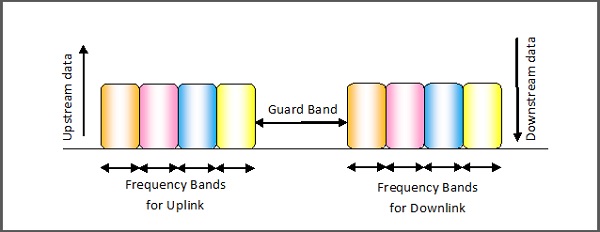
 Data Structure
Data Structure Networking
Networking RDBMS
RDBMS Operating System
Operating System Java
Java MS Excel
MS Excel iOS
iOS HTML
HTML CSS
CSS Android
Android Python
Python C Programming
C Programming C++
C++ C#
C# MongoDB
MongoDB MySQL
MySQL Javascript
Javascript PHP
PHP
- Selected Reading
- UPSC IAS Exams Notes
- Developer's Best Practices
- Questions and Answers
- Effective Resume Writing
- HR Interview Questions
- Computer Glossary
- Who is Who
Frequency Division Duplex
Frequency division duplex (FDD) is a communication technique where the connected parties can communicate with each other in both directions through use of separate frequency bands for transmitting and receiving.
Since FDD uses different frequency bands for upstream data and downstream data, the sending and the receiving signals do not interfere with each other.

FDD in Cellular Networks
Cellular networks use FDD to separate the channels. One block of the electromagnetic spectrum is allocated for uplink, which carries data from mobile phones to a base station. A different block of the spectrum is allocated to downlink, carrying data from a base station to mobile phones. Each of the blocks are divided into a number of channels.
In advanced mobile phone systems (AMPS), 832 full-duplex channels are used, each comprising of a pair of simplex channels, one for uplink and the other for downlink. The uplink channels are separated from the downlink channels through guard bands.
Other Application Areas
Asymmetric digital subscriber line (ADSL)
Very-high-bitrate digital subscriber line (VDSL)
IEEE 802.16 WiMax(Worldwide Interoperability for Microwave Access) Frequency Division Duplexing mode

